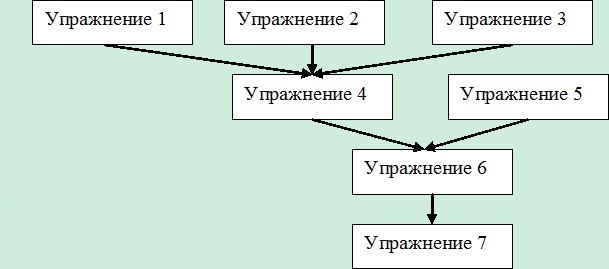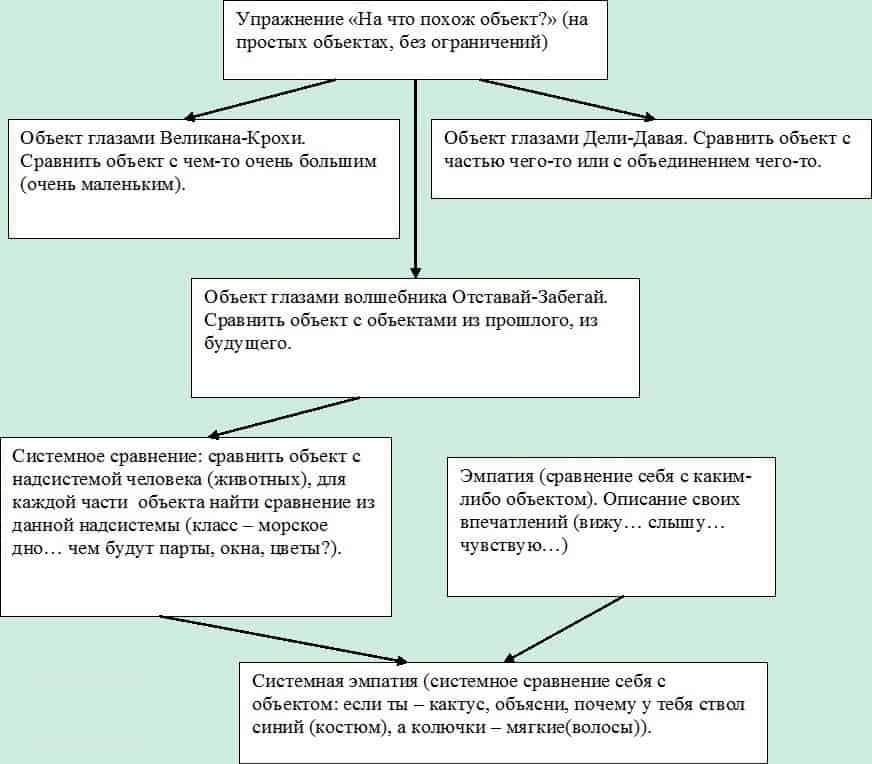photo from the website ria.ru There are many creative teachers in the world who have something to share with their colleagues. Why is there still a great shortage of high-quality teaching materials?
The answer is simple: those who know how to work often do not know how to write. Meanwhile, the experience of our experimental sites shows that any teacher can describe his developments if he gets a little help in this.
Introduction
This work was written to help teachers of experimental sites for problem-based learning based on OTSM-TRIZ. The examples provided here illustrate the techniques used in this pedagogical approach. However, the author hopes that other teachers who want to describe their methodological developments will also find useful advice here.
The recommendations are described in the form of a template. By replacing the template text with the author’s text in accordance with these recommendations, the teacher will be able to create his own methodological development. This approach was borrowed from my supervisor, Professor V.V. Guzeev [1], whose dissertation research template was the basis for my own Ph.D. thesis.
The second section provides direct recommendations for creating a methodological development, and the third section contains a list of references used.
Composition and content of methodological development
Subject
Usually the topic is built on the principle: subject of research - object of research. The order of the parts of the title may vary.
The object indicates the area to which your development belongs, and the subject indicates what aspects, features you are going to change, the distinctive features of your technique. In other words, an object is the closest supersystem in which you work, and an object is that subsystem or feature that your work changes and improves.
Sometimes the wording itself indicates the GOAL - why this object needs to be improved.
Examples:
Using the Point of View (SUBJECT) model as a tool
integration of speech development and natural history courses (OBJECT)
to form a systemic perception and emotional attitude towards the world around us (GOAL).
The integration of natural history and speech development courses has been done before you, in this case this is the area in which you want to say your new word (object). But using the point of view model as a means to integrate these courses is something new that you have developed (subject).
The subject may have varying degrees of novelty, formulations such as “problems of using the technique...”, “features of using the technique... in the conditions...” are possible. In this case, the methodology itself will be the object (if it already existed before you), and the problems of its application, the features of its use in some new conditions will be the subject of research.
You may not be able to accurately formulate the topic right away. This is normal: if you are solving a pedagogical problem, you are not required to immediately know by what means it will be possible to solve it. Therefore, the goal and object are important at the input, and the object can become clearer later. Recommendations for formulating goals are given below.
Author information
Author of the methodological development (last name – first name – patronymic, place of work and position, contact information: preferably – email address, yours or the school’s address).
Example: Ivanova, Anna Petrovna, primary school teacher at school No. 1, N, teacher of the 1st category, [email protected]
Conditions of use
In this section please indicate
— Student population, characteristics of the population (if any).
— The program within which your methodology is applied.
— If your development is based on the author’s methodology, indicate the name of the basic methodology and its authors.
Example:
— Primary grades (1-2).
— Speech development course as part of the Russian language course
— Methodology for compiling a descriptive story from a picture (Murashkovska I.N., Valums N.P.).
Relevance, purpose and objectives
A well-formulated goal largely determines the success of the entire work. You should not formulate goals in “general terms”: to develop thinking and imagination - the fact of achieving such a goal cannot be verified. Let us indicate the requirements for the formulation of goals and objectives:
1. The goal must be formulated very specifically, so that it can be divided into understandable tasks, the results of which can be verified. 2. The goal must be considered in the general system of goals, i.e. Not only the goal should be clear, but the subgoals (tasks) with the help of which it will be achieved and the supergoals to achieve which your goal is needed. 3. Objectives indicate the changes that should happen to the student and manifest themselves in his behavior or in the results of his work (for example, in the texts he writes) as a result of applying your methodology. They are described by perfective verbs: teach how to write riddles like...; teach to distinguish between the name and meaning of a sign; teach how to use the system operator to write questions about a historical event, etc. We advise teachers who are familiar with OTSM-TRIZ to describe changes using the “element – feature names – feature values” model.
Below are several steps that are useful to take in order to formulate high-quality goals and objectives. This fragment of text (in italics) does not need to be included in the methodological development; it is needed in the process of working on the material.
To correctly formulate your goals and objectives, try doing the following:
1. Answer the question: “what are you going to change with your development?” Describe the expected result: WAS... – IS... And then remove those changes that you did not achieve or achieved using another technique, leave only those that directly relate to your work.
Example: WAS: children give an oral answer about a natural object, haphazardly, using cliches, talk without pleasure, speak with difficulty. – BECOME: children compose a coherent, emotional, imaginative story, examine objects from different angles, use their own comparisons, and tell stories with enthusiasm.
2. Make a chain of “WHY?”, this will help you see the supersystem of goals.
Example. Children know how to compose a coherent, complete story - Why? – To perceive the world around us holistically and systematically. - For what? – To be conscious of the world around you. - For what? – To be able to change the world around us.
Children compose a figurative story using their own comparisons - Why? – To build your own emotional relationship to the world around you. - For what? – To better understand yourself and the world around you.
3. Make a chain “FOR THIS?”, this will help you see the subsystems of goals.
Children compose a figurative story - for this they highlight the most striking fragments of the whole; build metaphors...
By completing this exercise, you will be able to obtain material for three points of methodological development (see below).
1. We get the rationale for the relevance of your work from the chain “WHY?” see paragraph 2 (example: “It is important to teach a child to navigate in the modern dynamic world, to form his own emotional attitude to what surrounds him. The development of figurative speech and associative thinking is one of the main tools for developing an emotional attitude to the world. No less important is the formation holistic, systemic perception of the surrounding world, necessary for a person to detect and solve the problems that arise before him. Together, systemic and figurative descriptions allow one to emotionally experience and appropriate methods of systemic perception of the world"). 2. The purpose of the work is to compare the initial situation (Was) with expectations (BECAME), see point 1 (example: “Teach the construction of a figurative story about an object based on the use of the “Point of View” model”). 3. Tasks - from the chain “WHAT?” see point 3 (example: “Teach to identify the signs of objects on behalf of which the story is built; teach to highlight the signs of surrounding objects that are important from the point of view of the narrator; teach to build figurative comparisons on behalf of the narrator; teach to build systemic comparisons on behalf of the narrator, combining images with unified system").
Facilities
Models, tools, methods
Indicate the models, tools, methods that are used in your development.
Example: The following models are used: “Element – feature name – feature value”, “Point of view”, morphological analysis.
Visual aids
Describe the visual aids you use. If well-known manuals described earlier are used, list them and provide links to the materials in which they are described.
Example: the manual “Circles of Lull” is used (link).
Description of the technique
The description of the methodology can be performed in various forms - it depends on its content.
The main problem of the description is that most of the methods we use are not implemented within one or several lessons, but require a more flexible training system. There is often a situation when the transition to a new stage provides a series of exercises from the previous stage, which can be carried out in any sequence. In this case, it is convenient to present the stages in the form of a diagram (Fig. 1). If your methodological development fits into a clear sequence of steps, there is no need for a diagram.
|
|
The example (Fig. 2) shows a fragment of the description of the methodology, which shows how individual exercises are connected to each other. The “compare an object on behalf of some wizard” exercise may be offered in different sequences, but they precede the system comparison. Empathy can be introduced in parallel with the “What is it like?” exercise. “Systemic empathy” must be preceded by empathy and systemic comparison.
For readers who are not familiar with OTSM-TRIZ pedagogy, we will explain the content of Figure 2. In the methods of developing speech and imagination, images of wizards are used, personifying the methods of transforming objects (Murashkovska I.N., Sidorchuk T.A.). Deli-Come divides objects into parts and combines the parts into a whole; Giant-Little One reduces or increases the size of objects, Lag-Run-Run moves objects along the time line.
If you have presented such a diagram, your next task is to describe each exercise in more detail. This can be done, for example, in the form of a table.
Table 1. Composition of the method
| Task, exercise, procedure | What does a teacher do | What are the children doing | Time, order of work | Recommendations, settings | What happens as a result |
| Compare an object with any other objects | Offers objects, asks questions | Answer questions | 3-5 minutes at the beginning of the lesson. The training is carried out until the result is achieved | First, choose objects that children know and have interesting shapes. Set up children for original answers: (“Vasya compared a boot with a pipe, Masha - with a canal. And the wizard D-D grouped the answers of Vasya and Masha (how?). Who will give an answer that D-D would be difficult to combine with the previous ones?” ) | Children find many comparisons and strive to find an original, unconventional comparison. |
Examples
Often in methodological developments, examples occupy the lion's share of the reader's space and attention. This sometimes leads to completely different results than the author expected. We have encountered cases where a teacher, having read the methodological material, is sincerely convinced that this material can only be used with the examples described in it. To use the “Picture without Stuttering” he needs the same picture with ducks, and the exercise “what does it look like?” must be done exclusively with a class key and glasses. The methodological development should be written in such a way that your colleagues do not copy it one-to-one, but can adapt it to the conditions of their educational process without violating the technology you propose.
Examples illustrate and make your proposals clearer and more specific. But in no case do they replace them.
Example. Let's play the game "What does it look like?" At the initial stage, use objects familiar to children with an interesting shape (for example, a key, glasses, a tree branch, an umbrella, etc.). Then move on to objects with other bright signs (a faucet with dripping water - sound, a burning light bulb - temperature, etc.).
Diagnostics
Diagnostics is a topic that requires separate discussion. As a rule, teachers’ methodological developments do not provide diagnostics; instead, they give examples of children’s works or statements. This enlivens the description of the technique, makes it more readable, but does not make it possible to evaluate the result. So, in lessons on speech development you can always expect 1-2 bright works, but this says absolutely nothing about the value of the methodology used in the lesson. Talented children write brightly and without special training, sometimes the teacher’s intervention only spoils the matter.
If the result of your methodological development can be represented by the creative products of students, it is necessary to show the work of at least 2/3 of the students in the class. This does not mean that you should waste time retyping children's essays or problems created by children. It is enough to attach photocopies of them to the description of the methodology. When publishing your design, we will decide how to illustrate it with children's work.
Another option is to use previously developed diagnostics. In this case, it is necessary to cite sources.
If you decide to offer your own diagnostics of the results of using your technique (for which you immediately deserve special thanks), then you need to answer two questions:
1. By what objects did you evaluate the results of your work? It can be
- observed behavior of children (children ask to conduct such lessons more often, bring additional material, play games suggested by the teacher during recess - such observations indicate an increase in motivation);
- products of children’s creative activity (essays, rules derived by children, tasks invented by them, etc.);
— results of performing special tasks, etc.
2. What characteristics will you evaluate?
It can be
- the presence of certain statements by students in the process of work,
- certain types of behavior of students (for example, if a child collects a piggy bank, practically without asking for help from the teacher and classmates and gets a result, one can judge independence in this type of activity); if a student uses systematic comparisons in the text, one can judge the maturity of the ability to make such comparisons);
— the number of correct answers to the proposed tasks; number of errors of a certain type, etc.
If you evaluate work in points, under no circumstances consider the arithmetic average as the result for the class. Two students who caught the flu that day, did not complete the work and received unities, will negate the results of at least four excellent students. Just count the number of twos, threes, fours, fives, etc. and the percentage of the number of this grade to the number of students who did the work. If the work is assessed, for example, on a ten-point scale, you can count the number of students whose results fall within certain intervals (for example, 0-5; 6-10; 11-20, etc.). The results can be reflected in a diagram.
conclusions
Briefly review what your work was about. What problems have you not yet been able to solve? Set yourself goals for the future.
Please do not forget that today many teachers in different parts of the country are waiting for your materials.
Bibliography and links
This list should contain all the materials that you used when creating your own methodological development.
— Materials published in the press (articles, books, textbooks, etc.);
- Materials posted on Internet sites (in this case, the address of the material on the network is given, for example, Murashkovska I.N., Valyums N.P. Picture without hesitation. [WWW document] URL https://trizminsk.org/e/ 2312.htm)
- Materials placed on CDs (example description: Nesterenko A.A., Belova G.V. Knowledge workshop: tools for problem-based learning based on OTSM-TRIZ // Effective educational technologies [Electronic resource]. - Electronic text , graphics, sound, video data (57.2 MB) - M.: LLC "Distance Technologies and Education", 2008. - Issue 1. - 1 electronic optical disk (CD-ROM) : sound ., color; 12 cm – 9.72 Mb.)
In the text of the article, references can be made to the publication numbers in the list, preferably indicating pages [1, pp. 34-35], or you can use the European system (full name of the author, year when the material was published), for example (Ivanov I.I. , 2007, p. 34).
If you are using ideas from colleagues that were communicated in a private conversation, instead of a link in brackets you can write (Ivanov I.I., private message)
The essence of the methodological work of a teacher of preschool children.
3
The essence of the methodological work of a child educator
preschool age.
1. The concept of methodological work and its goals.
The successful development of the system of additional education for children is unthinkable without the development of its theory and methodology. Methodological activity plays a significant role in this process.
| Methodical work - This is a holistic system of measures, based on the achievements of science, best practices and analysis of teachers’ difficulties, aimed at improving the skills of each teacher, at generalizing and developing the creative potential of the team, and at achieving optimal results in the education, upbringing and development of children. |
The purpose of methodological work
in preschool educational institutions is to create optimal conditions for the continuous improvement of the level of general and pedagogical culture of participants in the educational process.
The implementation of this goal of methodological activity is carried out through the organization of the activities of such organizational structures as:
- methodological associations of preschool teachers,
- scientific, methodological and pedagogical council,
- monitoring service,
- as well as the active involvement of teachers in self-education.
In modern conditions of development of our society, preschool educational institutions are assigned very responsible social tasks:
that generation of people, whose work and talent, initiative and creativity will determine the socio-economic, scientific, technical and moral progress of Russian society in the future. |
In this regard, shortcomings and errors in the educational work of preschool educational institutions, in educational management and in pedagogical science itself are becoming increasingly intolerant.
| Task The goal of the head and methodologist of a preschool institution is to develop a system, find accessible and at the same time effective methods of improving pedagogical skills. |
Today, due to the need to rationally and quickly solve educational problems, the role of the activities of the methodological service is increasing, the correct organization of which is the most important means of improving the quality of education, and the real level of methodological work in a preschool institution is becoming one of the most important criteria for assessing its activities.
| Therefore it is necessary to consider organization of methodological work in a preschool institution, |
2.Planning methodological work
| Methodical service is a connecting link between the life activity of the teaching staff, the state education system, psychological and pedagogical science, advanced pedagogical experience, promoting the formation, development and realization of the professional creative potential of teachers. |
The methodological service of preschool educational institutions in accordance with the Law of the Russian Federation “On Education”, focusing on the humanization of the purposeful process of education and training in the interests of the individual, society, and the state, implementing the principles of state policy in the field of education, is designed to ensure:
Belaya K.Yu. Methodological work in preschool educational institutions: Analysis, planning, forms and methods. - M.: Sfera, 2005. - P. 96. |
Planning of methodological work in preschool educational institutions is carried out on an analytical basis:
|
Any preschool educational institution exists in one of two modes:
- functioning
- or development (innovation).
| 1. Consequently, in a preschool educational institution that is in a stable mode functioning, The methodological service must ensure correction of the pedagogical process in cases of its deviation from the technology, methodology for implementing the program of education and training of preschoolers. |
| 2. If the team intends to work in innovation mode (new content of training or implementation of new pedagogical technologies), then this requires the creation of a new model of methodological work that ensures the transition of preschool educational institutions from a functioning mode to a development mode. Losev P.N. Management of methodological work in a modern preschool educational institution. - M.: Bustard, 2005. P. 152. |
In all cases, the purpose of the methodological service
- create an educational environment in which the creative potential of each teacher and the entire teaching staff will be fully realized.
This leads to the main tasks of methodological work:
1. Training and development of teaching staff, management of their professional development.
2. Identification, study, generalization and dissemination of advanced pedagogical experience of preschool teachers.
3. Preparation of methodological support for the implementation of the educational process.
4. Coordination of the activities of the preschool educational institution and the family in ensuring the comprehensive continuous development of pupils.
Basic approaches to organizing methodological work in preschool educational institutions
based on:
| system-active approach: understanding the goals and objectives of the preschool educational institution, its status and conditions, as well as ensuring the integrity of the educational process in the context of the use of variable programs and technologies, taking into account the influence of external and internal relations on it; person-centered approach: ensuring a more complete disclosure of the capabilities and abilities of each teacher and child, the team as a whole, focusing on the development of professional and personal qualities of teachers using the example of a methodologist and senior educator; differentiated approach : taking into account the level of professional competence and individual educational needs in building a system of methodological work in preschool educational institutions; free self-determination approach: free choice of each teacher of educational programs and ways of self-realization; motivational-stimulating approach: the use of various incentives that arouse interest and motives for activity; corrective approach: timely elimination of deficiencies identified during pedagogical monitoring and the causes that cause them. |
Today there is a problem of low efficiency of methodological work in many preschool educational institutions.
The main reason is the formal implementation of the systemic approach, its replacement with an eclectic, random set of recommendations of an opportunistic nature, the implantation of far-fetched techniques and ways of organizing upbringing and education.
Methodological work should be proactive in nature and ensure the development of the entire educational process in accordance with new achievements of pedagogical and psychological science.
3.Methodological support of the methodological process
One of the core conditions for the life of a preschool educational institution is methodological support for the methodological process. This is where the organization of methodological work begins in any preschool educational institution.
The preschool educational program and methodological complex is selected taking into account:
|
Through the self-government body of the preschool educational institution, the pedagogical council, a program is approved for the implementation of the educational process that is most conducive to the conditions for the selection of methodological support.
Thus, the educational process in all groups of preschool educational institutions is carried out according to a comprehensive program that correlates with the social order and the type of preschool educational institution.
The effectiveness of the educational process in preschool educational institutions also depends on the creation of conditions for its implementation. This determines the following directions of methodological work:
| 1. Organization of a preschool educational institution that corresponds to the content of the program, interests and needs of children of different ages: — development of methodological recommendations for RPPS of preschool educational institutions; — ensuring the selection of toys, games, and manuals for working with children according to the program, taking into account modern requirements; — activation of teachers in the development of attributes and teaching aids. |
| 2. Correlation of the content of the educational process with the selected program: — formation of a data bank on the implementation of the program and its individual sections; — analysis of the implementation of decisions of teachers’ councils, medical and pedagogical meetings. |
| 3. Updating the content of methodological support (technologies, methods) in accordance with modern requirements. |
| 4. Development of a daily routine, a schedule of activities, and work schedules for clubs for each age group. |
| 5. Monitoring the balance of motor and intellectual, organized and independent activities of students. |
4. Structure, forms and methods of methodological work
| Methods of methodological work - These are ordered methods of activity to achieve goals. |
| Form - this is the internal organization of content, the design of segments, cycles of the methodological process, reflecting the system of its components and stable connections. |
According to the forms, methodological work is divided into group and individual.
Group include :
- participation of teachers in methodological associations of the city, district, preschool educational institution;
- organization of theoretical and scientific-practical conferences; teachers' councils.
Individual ones
include :
- individual consultations,
- conversations,
- mentoring,
- mutual visits,
- self-education.
In order to make the right choice for your team of forms and methods, you must be guided by:
|
The most effective forms of organizing methodological work are:
- teachers' council;
- seminars, workshops;
- open views;
- medical and pedagogical meetings;
- consultations;
- work of the creative team.
External advanced training occurs:
- by attending advanced training courses;
- training in educational institutions;
- participation in the work of methodological associations of the region.
Internal professional development occurs through various forms of methodological work with teachers in preschool educational institutions:
- participation in the work of the council of teachers;
- training at seminars and workshops;
- consulting, etc.
| In methodological work, a special place is given to the principle of an individually differentiated approach to the pedagogical activities of educators and specialists. |
In modern conditions, methodological work with personnel should be built on a diagnostic basis, taking into account the needs of each teacher.
5.Methodological office as a center for methodological work
| The center of all methodological work of the preschool educational institution is the methodological office. |
He plays a leading role:
- in providing assistance in organizing the educational process,
- ensuring their continuous self-development,
- generalization of advanced pedagogical experience,
- increasing the competence of parents in matters of raising and educating children.
| Methodical office - this is a piggy bank of the best traditions of preschool education, so the task of the deputy. head according to VMR:
|
| Methodical office The preschool educational institution must meet
|
The implementation of the information and analytical function of preschool education management determines the formation of an information data bank in the methodological room, where the sources, content, and direction of information are determined.
DOW information bank
| Bank of external information | Bank of internal information |
| 1. Regulatory documents of the Legislation of the Russian Federation; | 1. Regulatory documents regulating the activities of preschool educational institutions; |
| 2. Organization of methodological work in preschool educational institutions; | 2. Planning the activities of preschool educational institutions; |
| 3. Child development in the educational space of preschool educational institutions; | 3. Organization and management of educational activities of preschool educational institutions; |
| 4. Organization of interaction between preschool educational institutions and families and schools; | 4. Control and regulation of educational activities of preschool educational institutions. |
| 5. Information from periodicals of preschool educational institutions. |
In the methodological room of the preschool educational institution:
|
Thus, as part of the implementation of the main tasks of methodological work, the methodological office is the center for collecting pedagogical information,
as well as a creative laboratory for teachers and parents.
The result of methodological work in preschool educational institutions should be:
|
Bibliography
1. Bagautdinova S.F. Features of methodological work in a modern preschool educational institution. // Management of preschool educational institutions. - 2004. - No. 3. ? pp. 82-85.
2. Volobueva L.M. Active teaching methods in the methodological work of preschool educational institutions. // Management of preschool educational institutions. - 2006. No. 6. — P. 70-78.
3. Lipchanskaya I.A. Monitoring the functioning and development of preschool educational institutions: methodological recommendations. - M.: Sphere shopping center, 2009.
4. Markova L.S. Management activities of the head of a social institution. ? M., 2005.
5. Nikishina I.V. Diagnostic and methodological work in preschool educational institutions. - Volgograd, 2007.
6. Falyushina L.I. Quality management of the educational process in preschool educational institutions. - M.: ARKTI, 2009.



![Literacy lesson in the preparatory group “Sounds [K[-[K'] and the letter K”](https://properbooks.ru/wp-content/uploads/zanyatie-po-obuchenii-gramote-v-podgotovitelnoj-gruppe-zvuki-k-k-330x140.jpg)

